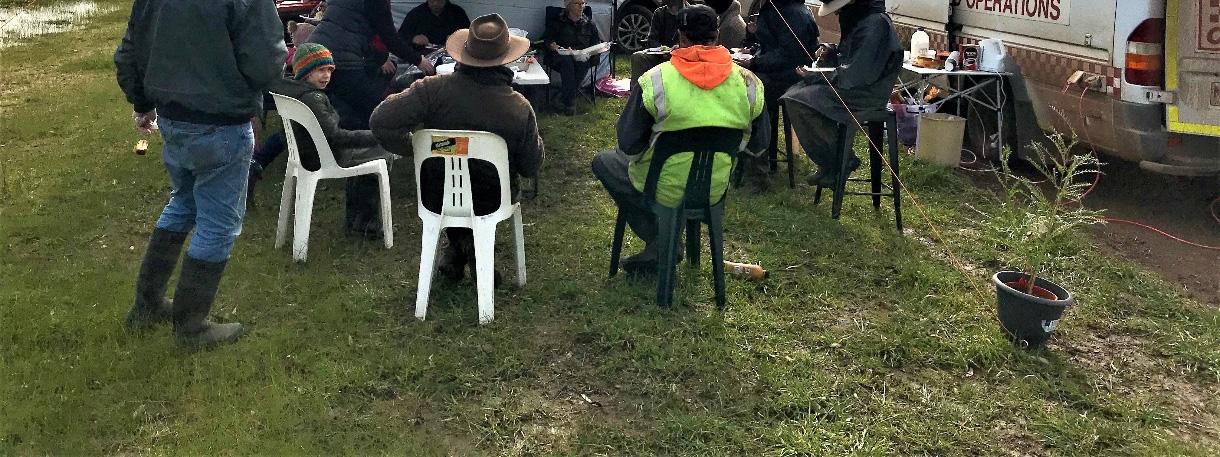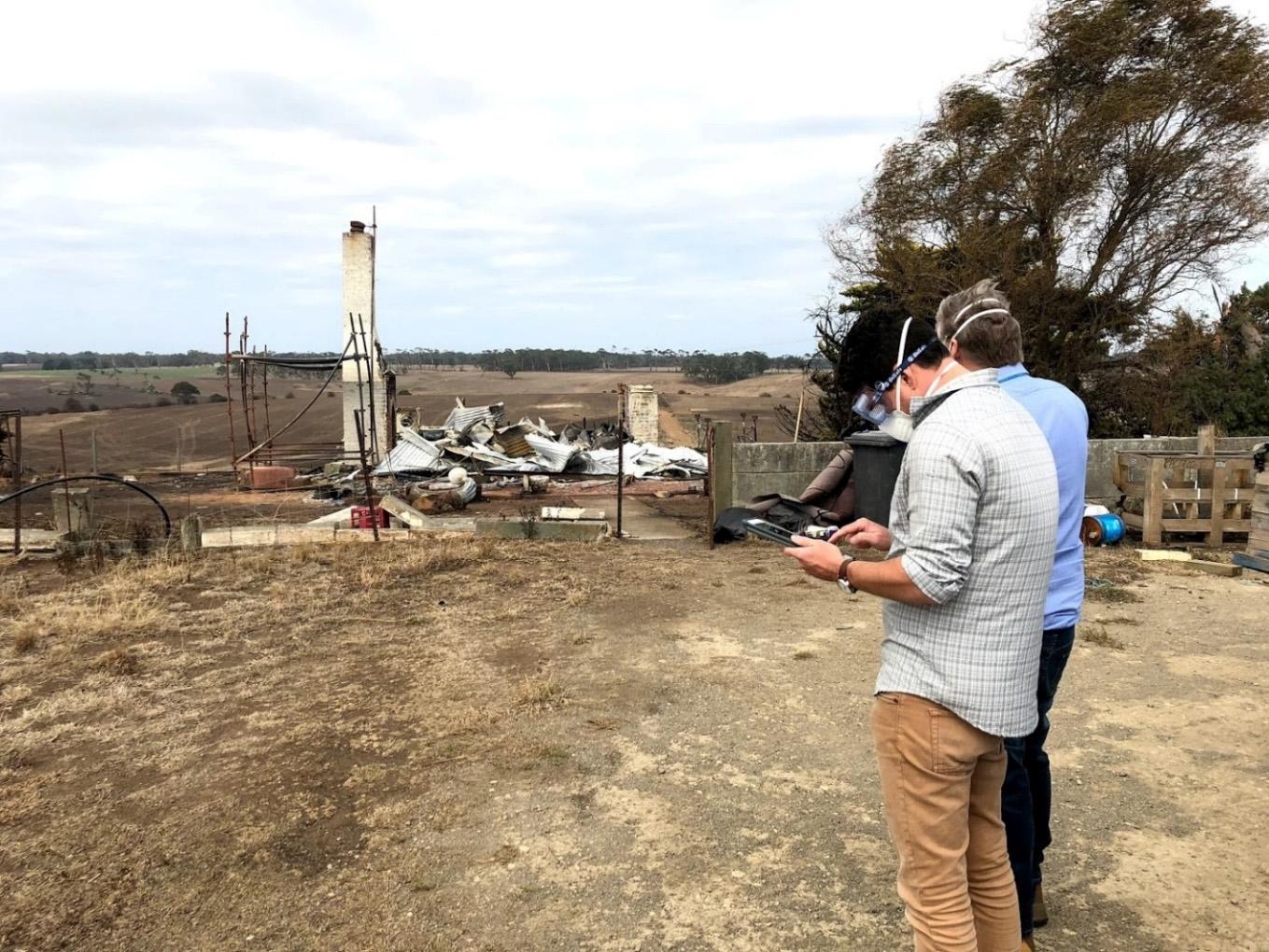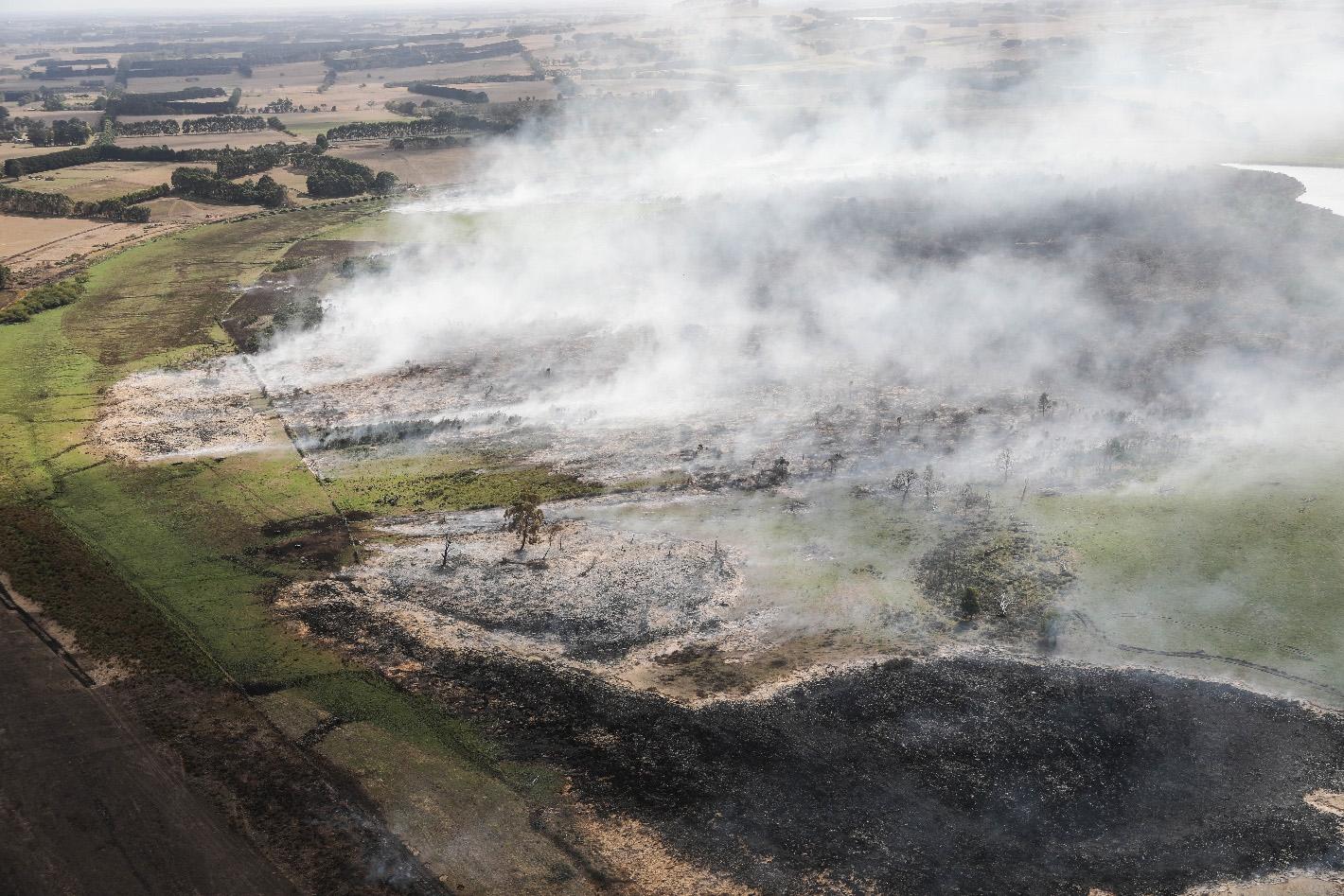
13 minute read
3.4 Capability and capacity for impact assessment
Finding 7
The Inspector-General for Emergency Management finds that: there is a high level of capability for initial impact assessment (IIA) in Class 1 emergencies particularly among responder agencies. capability for secondary impact assessment and IIA in Class 2 emergencies is less consistent across the sector, but individual organisations were well placed to collect and analyse the impact assessment data relevant to their recovery responsibilities and business as usual requirements.
Impact assessment relies on the accurate and reliable collection of information describing the effects of an emergency. The technical expertise, equipment and contextual knowledge required to collect data varies. Some impacts can be easily assessed by observing the damage or collating reports. Other impacts require technical expertise or specialised equipment to accurately measure and report. Stakeholders’ feedback and a review of sector doctrine did not provide any specific methodology for impact assessment. Internationally, Damage and Loss Assessment (DaLA) is used in multiple jurisdictions [63, 64] and the Queensland Reconstruction Authority use DaLA to underpin its impact assessment processes. The DaLA methodology outlines triggers for data collection, baseline data sources, data collection practices and assembly of the data collection team. The United Nations and World Bank have produced comprehensive guides for using the DaLA methodology [63, 64]. While the methodology does not differ substantially from the impact assessment practices undertaken in Victoria, the process and associated capabilities required is well documented.
Parks Victoria aerial capacity during the 2009 Cathedral Fire, Wilsons Promontory (Image: Parks Victoria)
State and regional capability and capacity
Across the sector there is variation in capability of personnel to conduct impact assessments. Responder agency and government department personnel typically have defined roles and relevant training or expertise in assessing the impacts they are tasked to report on. For responder agencies – in particular CFA, MFB and VICSES – personnel have significant training and expertise in impact assessment (see Box 3, p.42) and will typically respond to requests for IIA [65]. Responder agencies submitted a variety of documents to IGEM outlining the training undertaken by personnel and the well-practised procedures in place to guide impact assessment. For example, CFA has strong ground and air observation training programs and procedures which ensure a high level of capability among its personnel tasked with impact assessment duties. The procedures and training are reviewed regularly and reflect changes in technology and reporting methods. Government department personnel are likely to collect SIA data in domains that are relevant to their typical business activities. Parks Victoria and DELWP have expertise in environmental and natural recovery aspects of impact assessment [29]. Likewise, DEDJTR are well equipped to assess impacts with economic consequences. Several organisations have specialised impact assessment teams who are deployed to different emergencies depending on intelligence from situation reports and incident controller observations. MFB and CFA are both identified in the EMMV as key support providers for IIA in support of state requirements [58]. DELWP train and deploy Rapid Response Assessment Teams (RRATs, formerly Bushfire RRATs), small groups of personnel trained in assessing impacts to public land and state forest. These organisations have dedicated training and exercising activities for impact (or damage) assessment [29]. Further, they have specialised equipment and technology readily available to facilitate impact assessment.
Recommendation 2
The Inspector-General for Emergency Management recommends that Emergency Management Victoria engage relevant organisations to continue to leverage current impact assessment capacity and capability. This work should be coordinated through the existing impact assessment working groups to: clarify current capability and capacity for impact assessment (including built, social, economic and natural impacts) identify opportunities to better leverage existing agency and department expertise and resources to greatest effect
identify current systems in use and the technical requirements and constraints to be addressed to transition to an integrated portal for collection, collation and reporting of data.
BOX 3
Australian deployment to Greece for impact assessment
On 23 July 2018, a series of wildfires started in the coastal areas of Attica, Greece. The wildfires severely impacted the areas of Kineta and Mati, burning approximately 8000 hectares, including 400 hectares within the Kineta township [66, 67]. The second fire in Mati was smaller, burning a total area of approximately 1200 hectares [67]. This fire was extremely intense and fast moving, fuelled by strong winds and high temperatures. Due to the response in Kineta there were insufficient resources to assess and respond to the fire in Mati. The insufficient resources, coupled with difficult weather conditions, the rapid spread of the fire and the difficult terrain, resulted in catastrophic destruction and deaths. The total death toll stands at 96 people, all from Mati [67-69]. On 1 August 2018, the Australian Government, via the Australian Embassy in Athens, received a request for assistance from the Greek Minister of Civil Protection – the Greek Government and its emergency services did not have the resources or the tools required to carry out a Rapid Damage Assessment (RDA) of the impact of the fires [67]. Emergency Management Australia worked with CFA, MFB, VICSES and Fire and Rescue NSW to identify and prepare suitable personnel for deployment as an Australian Government Disaster Assistance Response Team (DART). The team’s mission was to focus on RDA in Kineta and Mati utilising a Remotely Piloted Aircraft System and a Geographic Information System. The mission was originally for a seven-day deployment but was extended for an additional five days as a result of initial assessments conducted at the start of the operation. In Mati, DART conducted 4037 RDAs over four days, while at Kineta they conducted 2242 RDAs over a further four days [66, 67, 70]. The impact assessments conducted by the DART provided information on the level of damage to buildings and gave the Greek authorities information on which buildings were most in need of a structural report to contribute to the recovery effort. Based on this data, the authorities could effectively prioritise the building inspections and ensure the safety of the area. DART used the Fulcrum software (see p.47) to compile the damage assessment for each individual property. The DART mission to undertake RDA was successfully carried out. The response to the initial request was fast with the personnel quickly sourced across a variety of jurisdictions and the team promptly arrived in Greece where assessments were completed and reported to the Greek authorities within two weeks [67].

Rapid damage assessment in Mati, Greece (Image: MFB)
Local government capability and capacity
Local government personnel tasked to conduct impact assessment are likely to be less experienced in impact assessment. Despite this, local government holds significant value in impact assessment due to their contextual knowledge of communities but is limited in capacity. The emergency management teams in LGAs are often comprised of personnel whose emergency management roles or duties can comprise only a part of their position description. Due to individual LGAs not having to frequently manage major emergencies, personnel may not regularly practise their impact assessment capabilities. Consequently, personnel with limited training and experience may be required to assist with impact assessment. Local government stakeholders discussed limited training and experience in impact assessment as a known constraint in their capability and capacity to conduct impact assessment [71, 72]. Impact assessment coincides with other important emergency management relief and recovery activities and may commence in some locations while an emergency continues in another area. Less resourced LGAs, particularly regional LGAs, had small pools of personnel to draw upon in times of crisis. Larger metropolitan LGAs had increased capacity, however, impact assessment is one of many tasks required of them in the relief and recovery phases of emergency management. EMV’s micro-learnings training initiative for some of the new EM-Impact Project developments was presented to the SCRC Relief and Recovery Sub-committee [Agenda item 3.4; 19] and discussed at pre-season briefings for the 2018–19 summer season. Short, online videos and reading materials will be made available to increase access to impact assessment training. IGEM was not provided with any evidence of this part of the project, or its progress, but the initiative addresses a need within the sector for adaptable training opportunities. Datalink – the company which hosts CrisisWorks (see section 3.5, p.47) – offer on the ground support for local government to use its software during an emergency and advised IGEM it was also seeking funding to develop short videos and training materials for local government personnel that explain how to use the software in light of Victoria’s arrangements for impact assessment. Local government stakeholders identified collaborative networks as a means of increasing capacity in their region. Many LGAs participate in regional collaborations that offer impact assessment training and share resources. The North West Metropolitan Region Collaboration is one example of a collaboration who offer shared training opportunities and resources [73]. Stakeholders also referenced the Northern Victorian Integrated Emergency Management Cluster [74] which includes the City of Greater Bendigo, the Central Goldfields Shire, the Mount Alexander Shire Council, the Loddon Shire Council and the Campaspe Shire Council, who similarly support each other and share resources.
… the collaboration is fantastic. It's a great source of support of resource … So, we've got some councils that don't have a dedicated emergency management resource. We've got some councils that have got large teams of emergency management staff.
These regional collaborations for local government also provide a network for emergency management personnel to share information and offer on the ground support during emergencies. For example, local government stakeholders spoke of personnel from other Victorian local governments providing assistance in data entry, impact assessment and data reporting for the South-West Fires. In late 2018, EMV and local governments collaborated to support a SIA project officer position based in Manningham Council. The purpose of this initiative is to improve communication and developmental work concerning SIA between state and local government. The project officer and project were in the scoping phase at the time of writing. Regional collaborations have grown organically and are driven by a motivated workforce who recognise the benefits of working together. Local government should be encouraged and supported to strengthen and expand these collaborations. Support might come through offers of training and knowledge sharing from state and regional experts in impact assessment. Given their limited capacity, it is important to ensure changes in impact assessment are developed in collaboration with local government. IGEM notes that much of the work being coordinated by EMV is focused on streamlining and simplifying impact assessment to improve efficiencies for the entire sector including the local government tier.
Incorporating local knowledge
Finding 8
The Inspector-General for Emergency Management finds that local knowledge is not consistently leveraged for impact assessment purposes.
Local knowledge provides a critical context to the collection and reporting of impact assessment data. Much of the data and information required for impact assessment is only useful when presented in context of the pre-existing environment or community conditions. The resilience index project will, in part, provide some context for impact assessment data (see section 3.3 p.35). However, an understanding of community priorities and environmental conditions may be useful in identifying priority data for impact assessment and driving impact assessment activities. Local knowledge is also important for impacts that are less tangible and more difficult to measure (see Box 4, p.46). Local knowledge is important for emergencies of all scales; local, regional and state. Local and state government, and responder agency stakeholders felt that impact assessment would be improved by including a team member with local knowledge in incident management teams (IMTs). Knowledge of local roads, demographic characteristics, residential details and community facilities would facilitate timely data collection. It could also assist impact assessment data collectors in their interactions with those who have been impacted. There has been a concerted effort across the sector to incorporate local knowledge in a range of IMT activities. JSOP J2.04 defines the procedures for incorporating local knowledge in IMTs for bushfires [75]. Stakeholders noted current work on changes that would extend the JSOP to become policy across a broader range of emergencies. Local government personnel have other responsibilities that may limit their capacity to provide ongoing assistance to the impact assessment teams (and more broadly) during an emergency. As such, other community representatives may be called upon to assist. The capacity of community representatives may be affected when their own community experiences a large-scale emergency. This limitation has been previously identified in the sector [76]. For example, community representatives may hold volunteer positions that require them to assist in other response or relief activities.
The selection of community representatives needs to be well managed. Local government has an oversight of potential representatives and should be consulted to ensure suitable local knowledge is considered throughout the event. Individuals with appropriate knowledge and skills should be identified to ensure they reflect the community’s needs and can assist impact assessors with useful information. This is not always the case:
We’ll get these community people and these community “reps” but they’re not representative of the community. They’ve got massive conflicts of interest ... But that’s a key role that local government can do … because always they’ll get these people in – if they had made one phone call I could have given them a list of representatives from each town that represent those communities more than the people that they called up into those incident control centres.
IGEM notes that the findings and recommendations identified in this review could be addressed in part by involving local knowledge to direct and assist in the data collection activities of impact assessment. A well-directed effort to involve local knowledge may also help to communicate the purpose and progress of impact assessment activities to community members. IGEM notes that strategies to incorporate local knowledge and access community members may vary greatly across Victoria. Strategies for regional, peri-urban and urban communities would vary greatly as would strategies for different emergencies.
Recommendation 3
The Inspector-General for Emergency Management recommends that Emergency Management Victoria, with the support of Local Government Victoria, update, publish and share relevant impact assessment plans, operating procedures, manuals and impact assessment guidelines to ensure Incident Controllers or Incident Management Teams formally consult relevant local personnel. Appropriate local representation should be identified during pre-season activities and/or in the initial stages of an emergency through a brief consultation with local government emergency management personnel. Local representation should extend from response through to recovery to better align emergency management with community requirements.
JSOP J2.04 defines the procedures for integrating local knowledge in bushfire IMTs (Source emv.vic.gov.au)
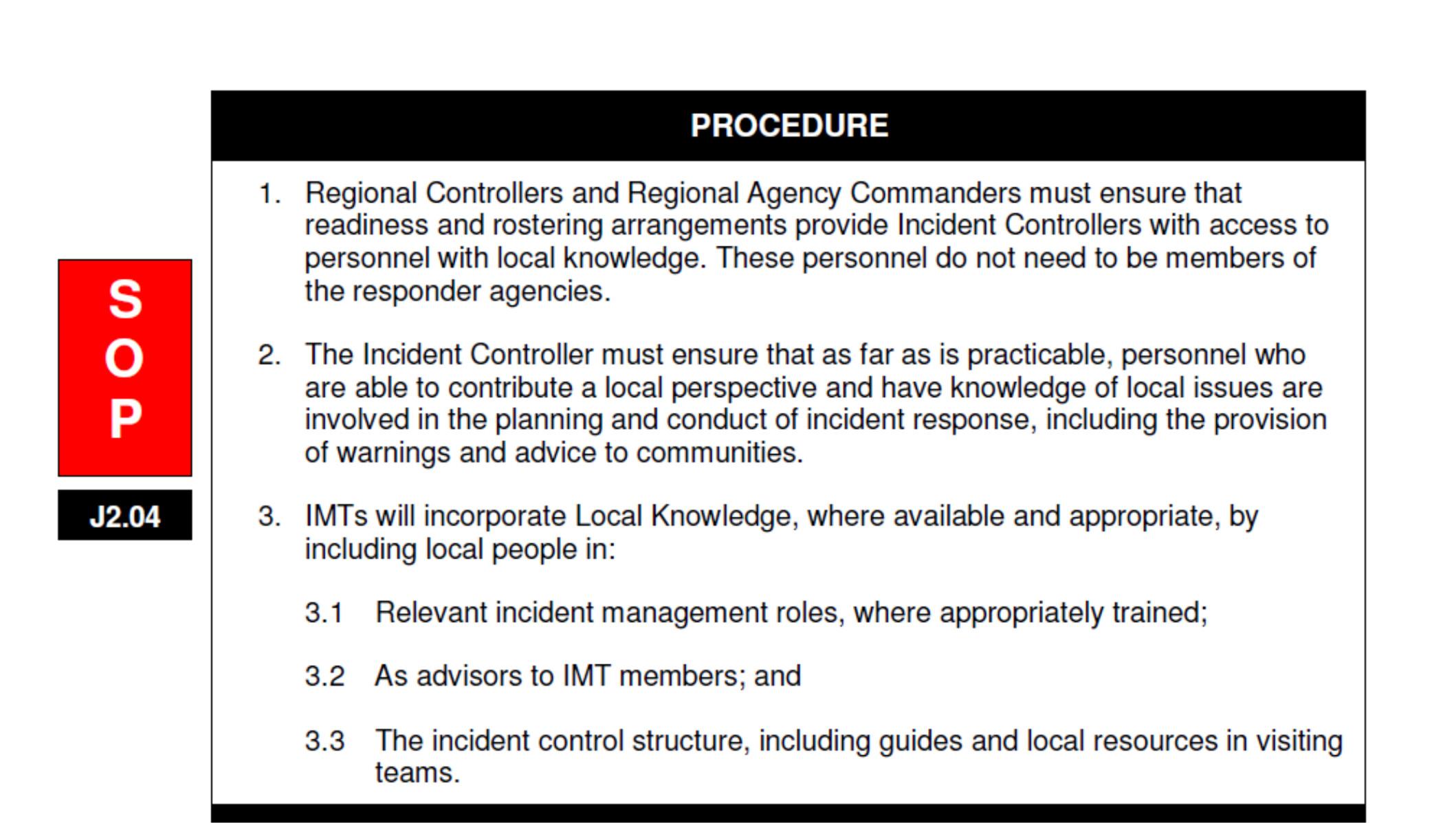
BOX 4
Contextualising impact assessment data with local knowledge
Post-emergency it is difficult to quantify psychosocial impacts and address these psychosocial needs for all individuals. Layering data with local knowledge creates a strong evidence base for recovery. Moyne Shire’s recent recovery actions following the South-West Fires illustrate the importance of understanding impact and addressing the needs of local communities. Local government personnel involved in emergency management built on impact assessment data and existing local knowledge to recognise the likelihood of severe mental health impacts in the aftermath of March 2018 fires. Local government personnel were aware of existing strains within the community and understood how the fires had impacted their community through the secondary impact assessment being conducted at the time. Through initial conversations with the community members, the team recognised that farmers were busy trying to repair their properties and continue their businesses. Despite receiving advice to form recovery committees and hold centralised ‘townhall’ meetings, the recovery team organised a vehicle to deliver its recovery outreach. The fires had caused significant disruptions to the local industry and family life. Community members were unlikely to take time out of their day to attend recovery forums and committees. The vehicle-based outreach allowed the recovery to come to the community. ‘Van-tastic’ is the resulting initiative where local farmers and residents are invited to gather together to share cake, a cup of tea and a sausage. Local government personnel are available to share information, suggest support services and answer questions. Local government personnel spoke of multiple instances of community members banding together to help each other out. Community members, some who had previously never engaged with each other beyond a cursory wave, have shared equipment, knowledge and stories to support each other in practical and emotional ways. This is an example where data and local knowledge have been used to foster positive community connections and emulate a ‘build back better’ approach.
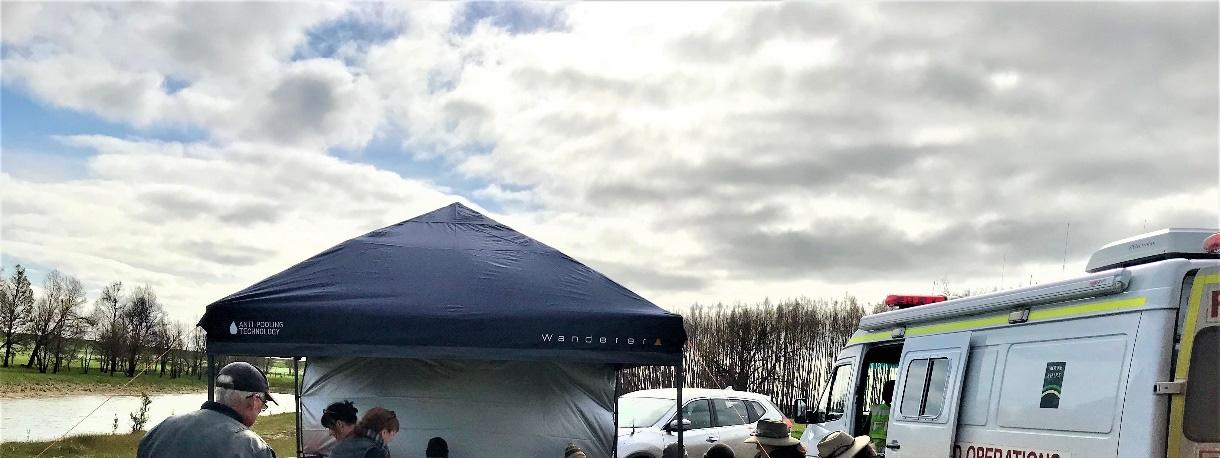
Moyne Shire’s recovery outreach vehicle - ‘Van-tastic’ (Image: Moyne Shire).
